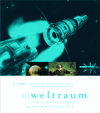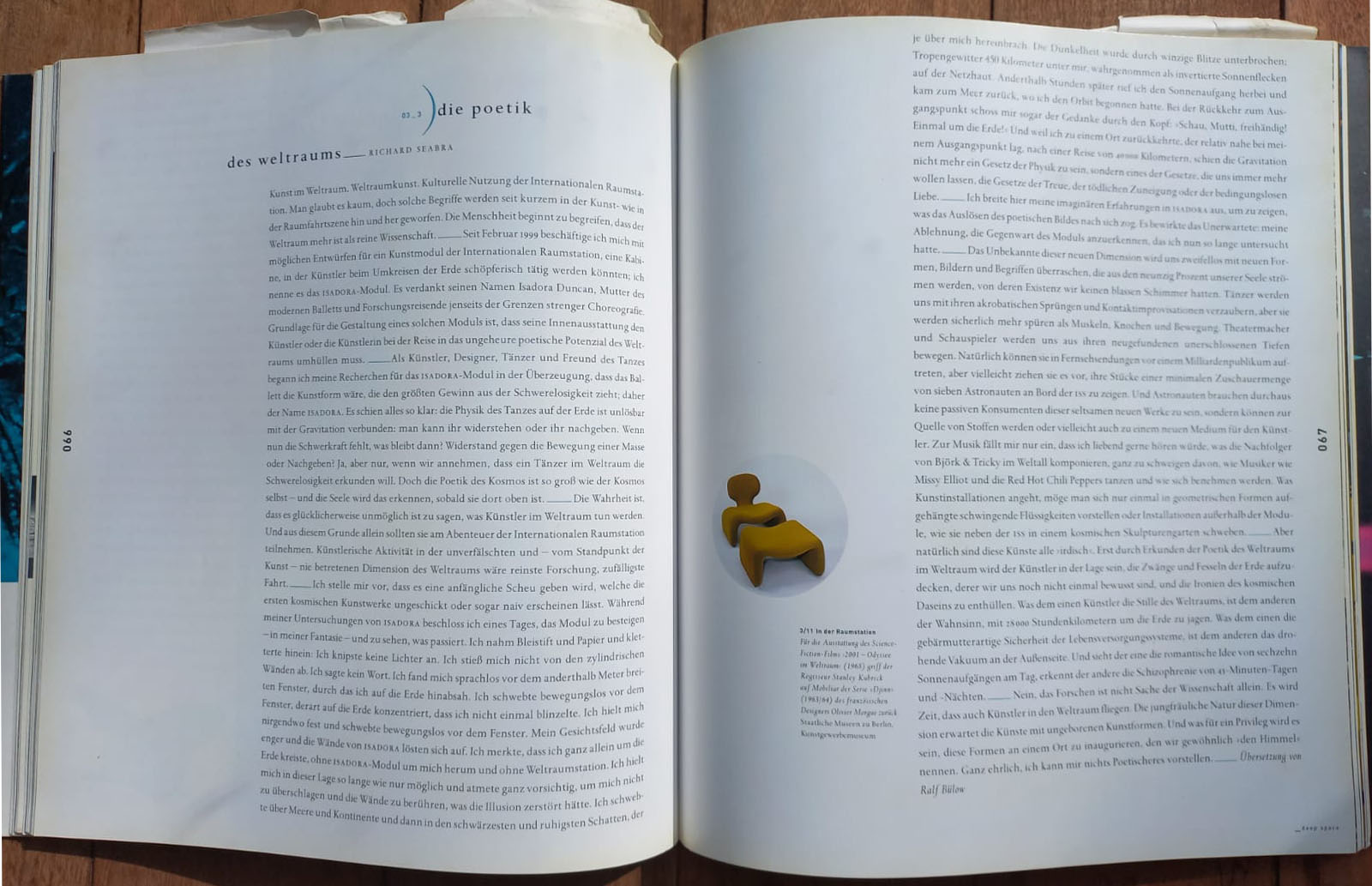
Article
by Ricky Seabra for the Seven Hills Millennium Exhibit
at the Martin Gropius Museum in Berlin, May 2000.
Appeared in Volume
3 Cosmos - Suns, Moons, Galaxies: Passage to the Unknown
ed. by Bodo-Michael Baumunk and Ralf Bčlow.
Deutsche (Die Poetik des Weltraums)
:::The Poetic Potential of Space:::
May 2000
Art in Space. Space Art. Cultural Utilization of the International Space Station. Believe it or not these are terms that are starting to be tossed around by the art community and the space community. Mankind is starting to realize that there is more to space than just the purely measurable. Since February 1999 I have been engaged in researching the possible design of an art module for the International Space Station, a module to which artists would be sent to create while in Earth's orbit; a module I call the ISADORA Module. It is named after Isadora Duncan, the mother of modern dance and an explorer outside the realm of rigid choreography. What is essential for the design of such a module is that its interior must be able to embrace the artist in his or her journey into the vast poetic potential of space.
As an artist, designer, performer and lover of dance, I came into the research of the ISADORA Module convinced that dance would be the art form to benefit most from being in microgravity; hence the name Isadora. It seemed so obvious: the kinetics of dance on Earth are inextricably connected to gravity: resist it or give into it. Take gravity away and what do you have? The resistance of momentum and the yielding to it? Yes, but only if we assume that all the dancer wants to explore in space is zero-gravity. But the poetics of space are as vast as space itself. . . and the soul will realize that as soon as it gets there.
The truth is, it is so pleasurably impossible to predict what artists will produce in space. And for this very reason alone artists SHOULD be part of the International Space Station venture. Artistic endeavor in the fresh and artistically unchartered dimension of space will amount to exploration at its purist; navigation at its blindest.
I can imagine there will be an initial awe that will render the first art works in space as awkward or even naive. As part of my research into ISADORA, I decided it was time to enter the module (in my imagination) to see what would happen. I picked up a pen and paper and I entered: I didn't turn on any lights. I didn't experiment with bouncing off of the cylindrical walls. I didn't say anything. I found myself dumbfounded before the 1.5 meter window looking out at Earth. I floated perfectly still in front of the window, so focused on the Earth, I didn't blink. I held on to nothing and floated perfectly still in front of the window. My vision became tunneled and the walls of ISADORA faded away. I realized that I myself was orbiting Earth alone with no ISADORA Module around me, no Space Station. I held this position for as long as possible, breathing carefully so as not to tumble and touch the walls thus breaking the illusion of orbiting alone. I floated over seas and continents then into the darkest and most quiet shadow that had ever brushed over me. The blackness was specked with minuscule lightning flashes; tropical storms 450 kilometers below perceived as negative sun spots on my retina. An hour and a half later I brought on the sunrise and came back to the seas where I had begun my orbit. I even thought to myself as I returned to where I started, "Look Mom! No hands! One orbit around earth!" And because I returned to a spot relatively close to where I had started, after traveling over 40,000 kilometers, gravity seemed no longer to belong to the laws of physics... but to those laws which keep us coming back for more. . . the laws of fidelity, fatal attraction and unconditional love.
I share my imaginary experience in ISADORA because of what evoking the poetic image did to me. It caused the unexpected: my refusal to even acknowledge the presence of the module I had been researching for more than a year.
The novelty of this new dimension will undoubtedly surprise us with new forms, images and language that will pour forth from that 90% of the soul that we didn't even know existed. Dancers will enchant us with their share of acrobatics and contact improvisations, but they will surely be sensitized beyond muscle, bone and movement. Theater-makers and actors will emote from their newly found unknown depths. Sure they can perform in broadcasts to audiences of billions but may prefer the ritual of presenting works to a petite audience of seven astronauts aboard the ISS. Astronauts, on the other hand, need not be passive spectators to these strange new works but can be a source of material or, perhaps, explored as another medium by the artist. In terms of music, all I can say is I would just love to hear what the likes of Bjork & Tricky would compose in space, not to mention to see how musicians like Missy Elliot and the Red Hot Chili Peppers would dance let alone behave. And as for installation art, imagine suspended trembling liquids holding up geometric forms or installations outside the module gliding along side the ISS in a space sculpture garden.
But of course the arts I have mentioned are "earthly". Only by exploring the poetics of space in space will the artist be able to unveil the constraints and bonds to earth of which we are not even aware and reveal the ironies of being in space. What for some artists will be the serenity of orbit, others may perceive as the madness of traveling at 28,000 kilometers an hour. What for some will be the womb-like security of life support systems, others may perceive as the looming danger of the vacuum outside. And what for some will be the romantic idea of 16 sun rises a day, others may perceive as the schizophrenia of 45 minute days and 45 minute nights.
No, exploration is not the province of science alone. It's time that artists go into space too. The pristine nature of this dimension awaits the arts with unborn art forms. And what a privilege it will be to be able to inaugurate these forms in a place we have always called "the heavens" . . . I honestly can't think of anything more poetic.

Article
by Ricky Seabra for the Seven Hills Millennium Exhibit
at the Martin Gropius Museum in Berlin, May 2000.
Appeared in Volume
3 Cosmos - Suns, Moons, Galaxies: Passage to the Unknown
ed. by Bodo-Michael Baumunk and Ralf Bčlow.
See other catalogues for the Seven Hills Exhibit.
: : : Die Poetik des Weltraums : : :
von Ricky Seabra, May 2000
Kunst im Weltraum. Weltraumkunst. Kulturelle Nutzung der Internationalen Raumstation. Man glaubt es kaum, doch solche Begriffe werden seit kurzem in der Kunst- wie in der Raumfahrtszene hin und her geworfen. Die Menschheit beginnt zu begreifen, dass der Weltraum mehr ist als reine Wissenschaft.
Seit Februar 1999 beschäftige ich mich mit möglichen Entwürfen für ein Kunstmodul der Internationalen Raumstation, eine Kabine, in der Künstler beim Umkreisen der Erde schöpferisch tätig werden könnten; ich nenne es das ISADORA-Modul. Es verdankt seinen Namen Isadora Duncan, Mutter des modernen Balletts und Forschungsreisende jenseits der Grenzen strenger Choreographie. Grundlage für die Gestaltung eines solchen Moduls ist, dass seine Innerenausstattung den Künstler oder die Kčnstlerin bei der Reise in das ungeheure poetische Potenzial des Weltraums umhüllen muss.
Als Künstler, Designer, Tänzer und Freund des Tanzes begann ich meine recherchen für das ISADORA-Modul in der Überzeugung, dass das Ballett die Kunstform wäre, die den größten Gewinn aus der Schwerelosigkeit zieht; daher der Name Isadora. Es schien alles so klar: die Physik des Tanzes auf der Erde ist unlösbar mit der Gravitation verbunden: man kann ihr widerstehen oder ihr nachgeben. Wenn nun die Schwerkraft fehlt, was bleibt dann? Widerstand gegen die Bewegung einer Masse oder Nachgeben? Ja, aber nur, wenn wir annehmen, dass ein Tänzer im Weltraum die Schwerelosigkeit erforschen will. Doch die Poetik des Kosmos ist so groß wie der Kosmos selbst. . . und die Seele wird das erkennen, sobald sie dort oben ist.
Die Wahrheit ist, dass es glücklicherweise unmöglich ist zu sagen, was Künstler im Weltraum tun werden. Und aus diesem Grunde allein sollten sie am Abenteuer der Internationalen Raumstation teilnehmen. Künstlerische Aktivität in der unverfälschten und - vom Standpunkt der Kunst - nie betretenen Dimension des Weltraums wäre reinste Forschung, zufälligste Fahrt.
Ich stelle mir vor, dass es eine anfängliche Ehrfurcht geben wird, die die ersten kosmischen Kunstwerke ungeschickt oder sogar naiv erscheinen lässt. Während meiner Untersuchungen von ISADORA beschloss ich eines Tages, das Modul zu besteigen (in meiner Fantasie) und zu sehen, was passiert. Ich nahm Bleistift und Papier und kletterte hinein: Ich knipste keine Lichter an. Ich stieß mich nicht von den zylindrischen Wänden ab. Ich sagte kein Wort. Ich fand mich sprachlos vor dem anderthalb Meter breiten Fenster, durch das ich auf die Erde hinabsah. Ich schwebte bewegungslos vor dem Fenster, derart auf die Erde konzentriert, dass ich nicht einmal blinzelte. Ich hielt mich nirgendwo fest und schwebte bewegungslos vor dem Fenster. Mein Gesichtsfeld wurde enger und die Wände von ISADORA lösten sich auf. Ich merkte, dass ich ganz allein um die Erde kreiste, ohne ISADORA-Modul um mich herum und ohne Weltraumstation. Ich hielt mich in dieses Lage so lange wie nur möglich und atmete ganz vorsichtig, um mich nicht zu überschlagen und die Wände zu berühren, was die Illusion zerstört hätte. Ich schwebte über Meere und Kontinente und dann in den schwärzesten und ruhigsten Schatten, der je über mich hineinbrach. Die Dunkelheit wurde durch winzige Blitze unterbrochen; Tropengewitter 450 Kilometer unter mir wahrgenommen als invertierte Sonnenflecken auf der Netzhaut. Anderthalb Stunden spŐter rief ich den Sonnenaufgang herbei und kam zum Meer zurück, wo ich den Orbit begonnen hatte. Bei der Rückkehr zum Ausgangspunkt schoss mir sogar der Gedanke durch den Kopf: "Sieh, Mutti, freihändig ! Einmal um die Erde !" Und weil ich zu einem Ort zurückehrte, der relativ nahe bei meinem Ausgangspunkt lag, nach einer Reise von 40.000 Kilometern, schien die Gravitation nicht mehr ein Gesetz der Physik zu sein. . . sondern eines der Gesetze, die uns immer mehr wollen lassen. . . die Gesetze der Treue, der tödlichen Zuneigung oder der bedingungslosen Liebe.
Ich breite hier meine imaginären Erfahrungen in ISADORA aus, um zu zeigen, was das Auslösen des poetischen Bildes nach sich zog. Es bewirkte das Unerwartete: meine Ablehnung, die Gegenwart des Moduls anzuerkennen, das ich nun so lange untersucht hatte. Das Unbekannte dieser neuen Dimension wird uns zweifellos mit neuen Formen, Bildern und Begriffen überraschen, die aus den neunzig Prozent unserer Seele strÜmen werden, von deren Existenz wir keinen blassen Schimmer hatten.
Tänzer werden uns mit ihren akrobatischen und improvisierten Taten verzaubern, aber sie werden sicherlich mehr spčren als Muskeln, Knochen und Bewegung. Theatermacher und Schauspieler werden uns aus ihren neugefundenen unerschlossenen Tiefen bewegen. Natürlich können sie in Fernsehsendungen vor einem Milliardenpublikum auftreten, aber vielleicht ziehen sie es vor, ihre Stücke einer minimalen Zuschauermenge von sieben Astronauten an Bord der ISS zu zeigen. Und Astronauten brauchen durchaus keine passiven Konsumenten dieser seltsamen neuen Werke zu sein, sondern können zur Quelle von Stoffen werden oder vielleicht auch zu einem neuen Medium für den Künstler. Zur Musik fällt mir nur ein, dass ich liebend gerne hören würde, was die Nachfolger von Björk & Tricky im Weltall komponieren, ganz zu schweigen davon, wie Musiker wie Missy Elliot und die Red Hot Chili Peppers tanzen und performen werden. Was Kunstinstallationen angeht, möge man sich nur einmal in geometrischen Formen aufgehängte schwingende Flüssigkeiten vorstellen oder Installationen außerhalb der Module, wie sie neben der ISS in einem kosmischen Skultpurengarten schweben.
Aber natürlich sind diese Künste alle "irdisch". Erst durch Erkunden der Poetik des Weltraums im Weltraum wird der Kčnstler in der Lage sein, die Zwänge und Fesseln der Erde aufzudecken, derer wir uns noch nicht einmal bewusst sind, und die Ironien des kosmischen Daseins zu enthčllen. Was dem einen Künstler die Stille des Weltraums, ist dem anderen der Wahnsinn, mit 28.000 Stundenkilometern um die Erde zu jagen. Was dem einen die gebŐrmutterartige Sicherheit der Lebensversorgungssysteme, ist dem anderen das drohende Vakuum an der Außenseite. Und sieht der eine die romantische Idee von 16 Sonnenaufgängen am Tag, erkennt der andere die Schizophrenie von 45-Minuten-Tagen und -Nächten.
Nein, das Forschen gehört nicht der Wissenschaft allein. Es wird Zeit, dass auch Künstler in den Weltraum fliegen. Die jungfräuliche Natur dieser Dimension erwartet die Künste mit ungeborenen Kunstformen. Und was für ein Privileg wird es sein, diese Formen an einem Ort zu inaugurieren, den wir gewöhnlich "den Himmel" nennen. . . Ganz ehrlich, ich kann mir nichts Poetischeres vorstellen.
Übersetzung von Ralf Bülow
7 Hügel - Bilder und Zeichen des 21 Jahrhunderts, 14 Mai - 29 Oktober 2000 im Martin-Gropius Bau Berlin. Einde Ausstellung der Berliner Festspiele. III Weltraum, Sonnen, Monde, Galaxien: Aufbruch ins Unbenkannte, 66-67.

Richard Seabra
